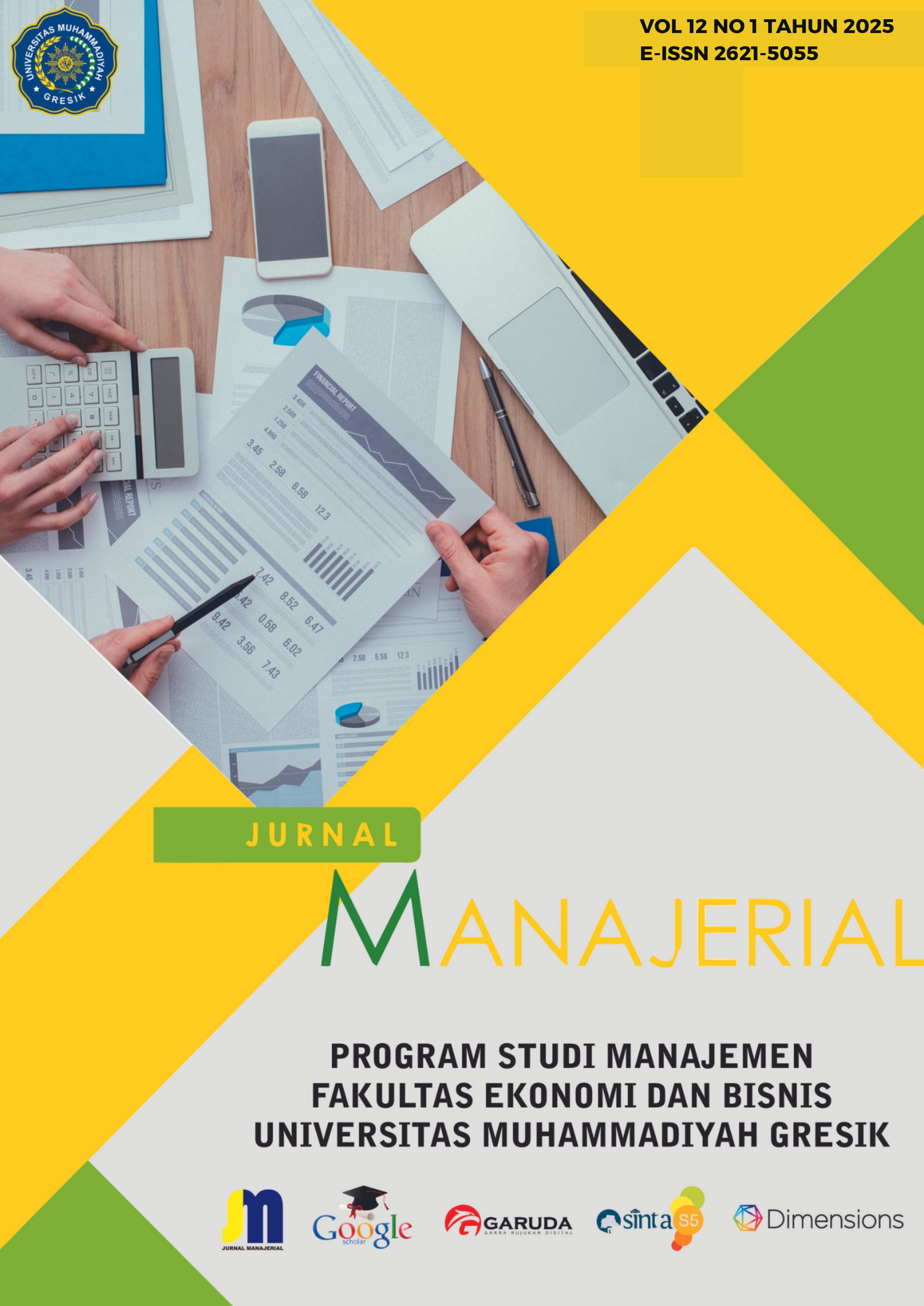Tinjauan Theory Planned Behavior Dalam Keputusan Memilih Program Studi Sarjana Kedokteran Gigi pada Perguruan Tinggi Di Kota Surabaya
DOI:
https://doi.org/10.30587/jurnalmanajerial.v12i01.8940Keywords:
Gender Stereotypes, Family Support, Career Prospects, Decision MakingAbstract
Background – Data from the Indonesian Medical Council , as of April 24, 2024 there were 279,321 doctors registered in Indonesia. Of these, 220,664 people or 79% are general practitioners and specialist doctors, dentists and specialist dentists combined, the number reached 59,422 people, equivalent to 21% of the total doctors registered nationally. The urgency of this research is that the problem of lack of interest in the faculty of dentistry in Indonesia is a serious concern for many parties. Along with the times, the faculty of dentistry with little interest can hinder the progress of the dental health field.The analysis of interest in entering the undergraduate dental program is important to understand the factors that influence students in choosing the dental program, such as interest, talent, career interest, expectations, environment, and educational facilities
Aim – The aim of this research is to analyze (1) the influence of gender stereotypes and family support on the decision to choose the dentistry study program, (2) the role of career prospects in moderating the influence of gender stereotypes and family support on the decision to choose the dentistry study program,
Design / methodology / approach – The sample for this research consists of 143 students from the Faculty of Dentistry, class of 2023, at three universities with a Faculty of Dentistry: Universitas Airlangga, Universitas Hang Tuah, and Universitas Muhammadiyah Surabaya, who served as respondents. The sampling technique used is Probability Sampling, specifically Stratified Random Sampling. The data used is primary data collected through the distribution of questionnaires to respondents. The analysis was conducted using the Partial Least Square (PLS) method with Smart PLS version 4.0 softwaredescribe the methodology used in your research.
Findings – The research results conclude that (1) gender stereotypes and family support can drive the decision to choose a dental medicine study program, (2) family support can drive the decision to choose a dental medicine study program, (3) career prospects strengthen the contribution of gender stereotypes to the decision to choose a dental medicine study program, but do not moderate the contribution of family support to the decision to choose a dental medicine study program
Conclusion –. The profession of a dentist, which requires high precision to diagnose health problems, is often associated with certain gender expectations. The support that individuals receive can increase their confidence in making choices. There is a tendency to avoid jobs that are considered incompatible with existing gender norms, which then leads individuals to adjust their career choices. Parenting patterns that give freedom and trust to children, while still emphasizing responsibility for decisions made, are not directly influenced by career prospects.
Research implication – The job of a dentist, which requires great precision to diagnose health problems, is often associated with gender-specific expectations. The support received by individuals can increase their confidence in making choices. There is a tendency to avoid occupations that are perceived to be incompatible with existing gender norms, leading individuals to adjust their career choices accordingly. Parenting that gives children freedom and trust, while emphasizing responsibility for decisions, is not directly influenced by career prospects.
Limitations – These studies may have used relatively simple measures of gender stereotypes or based on generalized perceptions, which may not fully capture how more subtle or specific gender stereotypes affect individuals. For example, gender stereotypes are not just limited to whether a profession is suitable for men or women, but could involve expectations regarding the character traits or roles expected in that profession (e.g. whether women are perceived to be more empathetic in the health profession). Therefore, the use of more complex measurement tools for gender stereotypes could help provide a more accurate picture.
References
Annisa Widyani, Abdul Saman, dan Nur Fadhilah Umar, 2023, Analisis Stereotip Gender Dalam Pemilihan Karier: Studi Kasus Pada Siswa Sekolah Menengah Pertama, Pinisi Journal Of Art, Humanity And Social Studies, Vol. 3 No. 1
Azwar, Saifuddin. 2020. Metode Penelitian. Pustaka Pelajar: Yogyakarta.
Badmus, Olalekan Taofeek , dan Loyiso C. Jita, 2023, Investigation of factors influencing career choice among STEM undergraduates in Nigeria universities, EURASIA Journal of Mathematics, Science and Technology Education, 19 (1)
Dahani, D., & Abdullah, S. M. (2020). Pengambilan Keputusan Jurusan Ditinjau Dari Dukungan Sosial Orangtua Pada Mahasiswa. Seminar Nasional Hasil Penenlitian Dan Pengabdian Pada Masyarakat V Tahun 2020, 2008, 386–391.
Devianti, Rika, 2015, Kontribusi Dukungan Orangtua, Teman Sebaya, dan Guru Bimbingan dan Konseling terhadap Minat Siswa pada Jurusan yang Ditempati di SMA, Jurnal Konseling dan Pendidikan, Volume 3 Nomor 2, 22-30
Fitraloka, Endang, Rini Risnawita Suminta dan Dewi Hamidah, 2022, Pengaruh Dukungan Keluarga terhadap Minat Baca Siswa Kelas IX MTs Nurul Islam Kota Kediri, HappinesVol. 6 Edisi 2 Tahun 2022
Ghozali, Imam. 2015. Aplikasi Analisis Multivariate dengan Program IBM SPSS 223. Edisi 8. Cetakan ke VIII. Semarang: Badan Penerbit Universitas Diponegoro. 53
Handayani, C. M. S., Ariprabowo, T., & Fauziyah. (2019). Kontribusi Reputasi Universitas PGRI Adi Buana Surabaya Terhadap Keputusan Mahasiswa Memilih Studi. Seminar Nasional Hasil Riset Dan Pengabdian, II, 175–183.
Hentschel, T., Heilman, M.E. & Peus, C.V. 2019. The multiple dimensions of gender stereotypes: A current look at men’s and women’s characterizations of others and themselves. Frontiers in Psychology, 10, article number 11.
https://doi.org/10.3389/fpsyg.2019.00011
Ismiati. 2018. Pengaruh Pengaruh Stereotype Gender Terhadap Konsep Diri Perempuan. TAKAMMUL: Jurnal Studi Gender dan Islam serta Perlindungan Anak. Vol 7(1)
Kimaro, A. R. & Ebenezer A. Lawuo, 2016. The Effects of Gender Stereotyping on Career Choice among Secondary School Students in Tanzania. International journal of Advanced Engineering, Management and Science (IJAEMS). Vol 2 (2).
Kortin, D.M., Hasan, M., Dinar, M., dan Ahmad, M., 2020, Determinan Yang Mempengaruhi Keputusan Memilih Program Lintas Minat Ekonomi, Jurnal Ekonomi Pendidikan Dan Kewirausahaan, 8(1), 67-78
Lukman Hendro dan Winata Sugim, 2017. Pemilihan karir sebagai dokter gigi bagi mahasiswa perguruan tinggi swasta dengan pendekatan Theory of planned behavior. Universitas Trumanegara. Vol XXI, No 02. 208-218.
Maloshonok , N G, I A Shcheglova, K A Vilkova, M A Abramova, 2022, Gender Stereotypes and the Choice of an Engineering Undergraduate Program, Educational Studies Moscow, No 3. Р. 149–186
Masykur, R., Syazali, M., Nofrizal, N., & Sugiharta, I. (2020). Model Matematika Pengambilan Keputusan Mahasiswa Dalam Memilih Jurusan: Dampak Minat Dan Bakat. Jurnal Pendidikan Matematika Dan IPA, 11(1), 13.
https://doi.org/10.26418/jpmipa.v11i1.30885
Muthia, & Zulkarnain, R. (2021). Analisis Tentang Pengambilan Keputusan Dalam Memilih Program Prodi Pendidikan Nonformal. Journal Of Lifelong Learning, 4(2), 108–117. https://doi.org/10.33369/joll.4.2.108-117
Noerchoida dan Nurdina, 2024, Membangun Kepuasan Karir Dengan Kecerdasan Emosional Dan Perilaku Inovatif: Moderasi Efikasi Diri, Jurnal Manajerial, Volume 11 Nomor 01. http://dx.doi.org/10.30587/jurnalmanajerial.v11i01.6186
Padrison dan Syamsir, 2022, Indonesia Influence Of Integrity, Career Development And The Provision Of Additional Employee Income On The Work Productivity Of Employees In The Regional Secretariat Of Pasaman Regency, Jurnal Manajerial, Volume 09 Nomor 03, http://dx.doi.org/10.30587/manajerial.v9i03.
Personat, G. Soto, S. Agut Nieto and M.R. Agost Felip, 2019, The Gender Gap In Career Choice: Influence Of Gender Stereotypes In The Process Of Career Decision Making, Prociding Conference : 12th annual International Conference of Education, Research and Innovation, 11-13 November, Seville, Spain
Riswani. 2015. Stereotipe Gender Dan Pilihan Kareer Di Kalangan Siswi Madrasah Aliyah (MA) Diniyah Puteri Pekanbaru Riau. Marwah. Vol 14(2)
Roof, J. (2016). What gender is, what gender does. London: University of Minnesota Press
Setyowati, R., Prabowo, W., & Yusuf, M. (2019). Pengambilan Keputusan Menentukan Jurusan Kuliah Ditinjau Dari Student Self Efficacy Dan Persepsi Terhadap Harapan Orang Tua. Jurnal Psikologi Pendidikan Dan Konseling: Jurnal Kajian Psikologi Pendidikan Dan Bimbingan Konseling, 5(1), 42– 48.
https://doi.org/10.26858/jppk.v5i1.7460
Sholihin, Mahfud, and Dwi Ratmono. 2020. Analisis SEM-PLS Dengan WarpPLS 3.0. Yogyakarta: Penerbit Andi.
Siregar, R N., Prabawanto, S., Mujin, A., dan Rangkuti, A.N., 2021, Faktor Dukungan Keluarga Dalam Mempengaruhi Minat Mahasiswa Memilih Jurusan Pendidikan Matematika di IAIN Padangsidimpuan, JIPMat, 6(2), 250-260
Solicha, F. N., Safitri, D., & Kurniawan, N. (2020). Peran Orangtua Dalam Menentukan Pilihan Kuliah Anak. Edukasi IPS, 4(2), 8–17
Sugiyono (2018). Metode Penelitian Kuantitatif , Kualitatif dan R&D. Bandung: Alfabeta
Sulistyawati, N. L. G. A., Herwati, N. T., & Julianto, I. P. (2017). Pengaruh Minat, Potensi Diri, Dukungan Orang Tua, Dan Kesempatan Kerja Terhadap Keputusan Mahasiswa Memilih Jurusan Akuntansi Program S1 UniversitasPendidikan Ganesha. E-Journal S1 Ak Universitas Pendidikan Ganesha, Vol. 8 No.2, 1-12
Taher, Saleh Sanaa, 2022, The influence of gender stereotyping and demographic factors on academic choice: The case of the University of Debrecen, Hungarian Educational Research Journal 12 (2022) 2, 145–163 DOI: 10.1556/063.2021.00056
Tulhalim, R., Bakkareng dan Delvianti. (2021). Faktor-faktor yang Mempengaruhi Pengambilan Keputusan Mahasiswa Memilih Program Studi Manajemen pada Fakultas Ekonomi Universitas Ekasakti Padang. Matua Jurnal (Pengembangan Ilmu Manajemen dan Bisnis) Vol. 3 No. 3. September 2021.
Utaminingsih, A. (2017). Gender dan Wanita Karir. Malang: UB Press.
Warmiyati, M.T., Wijayanti, S. H., & Darmoyo, S. (2018). Pemahaman Tentang Sosialsasi Gender Pada Siswa SMA di Jakarta. Jurnal Muara Ilmu Sosial, Humaniora, dan Seni, 2(1), 411-419. https://doi.org/10.24912/jmishumsen.v2i1.1718.
Widhya Nur Khasanah, 2022, Peran Prospek Kerja Dalam Memoderasi Pengambilan Keputusan Mahasiswa Memilih Program Studi Pendidikan Akuntansi, Jurnal Pendidikan Akuntansi Indonesia, Vol. 20 No . 02, Page 155 – 175
Yulyani, R. D. (2021). Pengaruh Potensi Diri, Motivasi Belajar, Lingkungan Sosial, Dan Prospek Kerja Terhadap Keputusan Mahasiswa Memilih Kuliah Di Prodi Bahasa Arab Uin Sultan Maulana Hasanuddin Banten. Jurnal Kajian






























 P-ISSN: 2354-8592 __ E-ISSN: 2621-5055
P-ISSN: 2354-8592 __ E-ISSN: 2621-5055 
